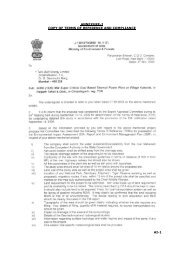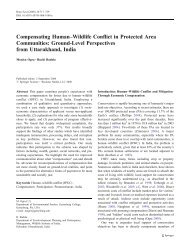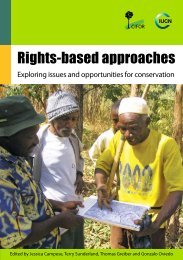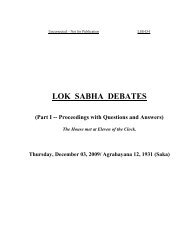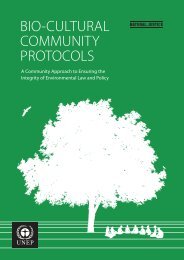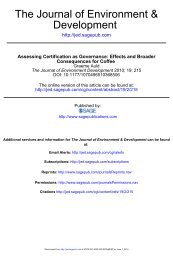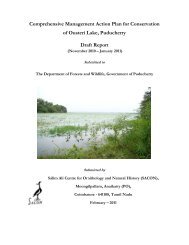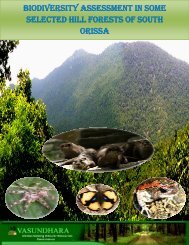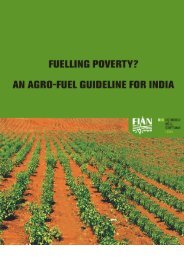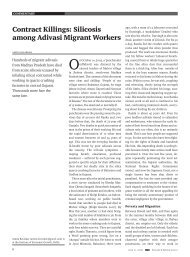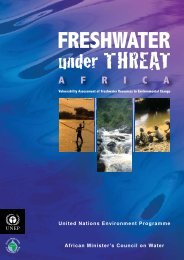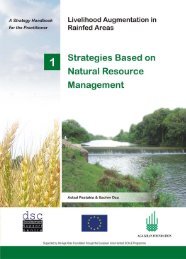The Financial Costs of REDD: - India Environment Portal
The Financial Costs of REDD: - India Environment Portal
The Financial Costs of REDD: - India Environment Portal
Create successful ePaper yourself
Turn your PDF publications into a flip-book with our unique Google optimized e-Paper software.
ased on the budget <strong>of</strong> the USDA Conservation Reserve Program (CRP) and,<br />
coincidentally, also estimates these costs at about US$1/ton CO 2 e. While these costs are<br />
not negligible, they are likely to be significantly smaller than the opportunity cost<br />
component <strong>of</strong> most <strong>REDD</strong> programmes.<br />
<strong>The</strong> Brazilian Amazon<br />
Brazil is responsible for approximately half <strong>of</strong> annual global deforestation (Hansen, 2008)<br />
and is the second largest emitter <strong>of</strong> GHG from deforestation, accounting for roughly 2.5<br />
percent <strong>of</strong> global GHG emissions. Roughly 75 percent <strong>of</strong> Brazil’s GHG emissions are<br />
from deforestation in the Amazon, and represent 8-14 percent <strong>of</strong> global emissions from<br />
land-use change.<br />
<strong>The</strong> main direct drivers <strong>of</strong> deforestation in the Amazon are cattle ranching, soybean<br />
monoculture and logging. Empirical estimates <strong>of</strong> opportunity costs per hectare are low<br />
and the studies reviewed here suggest that, at current carbon prices in both voluntary and<br />
compliance markets, carbon sequestration can compete with most prevalent land uses in<br />
the Amazon. Expressed in terms <strong>of</strong> cost per ton CO 2 e, the opportunity cost <strong>of</strong> cattleranching<br />
ranges from zero for traditional pasture and small scale ranching to US$2/ton<br />
CO 2 e for ranching on improved pasture. As roughly 80 percent <strong>of</strong> recently deforested<br />
land is used for ranching, the scope for achieving cost-effective reductions in<br />
CO2emissions through avoided deforestation seems promising.<br />
<strong>REDD</strong> is somewhat less competitive with soybean production, which has opportunity<br />
costs ranging from US$2.5 to US$3.4/ton CO 2 e. Nepstad et al. (2007) calculate that to<br />
eliminate deforestation completely in the Brazilian Amazon would cost US$1.49/ton<br />
CO 2 e, but that to reduce deforestation to 94 percent <strong>of</strong> projected levels would cost only<br />
half that amount at US$0.76/ton CO 2 e. <strong>The</strong> difference is largely attributable to the high<br />
opportunity costs <strong>of</strong> forgoing soybean production. Similarly, Vera Diaz and<br />
Schwartzman (2005) estimate the cost <strong>of</strong> eliminating deforestation at US$5.44/ton CO 2 e<br />
including soybean production and US$2.34/ton CO 2 e excluding soybean production.<br />
Adding an estimated US$1/ton CO 2 e in implementation and transaction costs to the<br />
opportunity cost estimates reviewed above increases the total costs <strong>of</strong> avoided<br />
deforestation significantly. For the highest opportunity cost estimates reviewed, i.e. highproductivity<br />
timber harvest followed by ranching and soybean production, the addition<br />
<strong>of</strong> implementation and transaction costs increases the costs to US$7.1/ton CO 2 e.<br />
Indonesia<br />
In 2007, Indonesia became the third largest emitter <strong>of</strong> GHGs globally. Roughly 85<br />
percent <strong>of</strong> Indonesia’s emissions are due to deforestation, forest degradation and forest<br />
fires. Indonesia is the world’s top emitter <strong>of</strong> GHGs associated with the draining <strong>of</strong><br />
peatlands which is responsible for over five percent <strong>of</strong> annual global emissions <strong>of</strong> GHGs<br />
from human activities (Joosten 2009). <strong>The</strong> rate <strong>of</strong> deforestation has increased in recent<br />
years from 1.61 percent per year (1990–2000) to 1.91 percent per year (2000–2005) while<br />
the annual loss <strong>of</strong> primary forest has increased by 25 percent over the same period.<br />
Clearly, Indonesia’s extensive tropical forest cover is threatened with rapid degradation<br />
and conversion.<br />
<strong>The</strong> direct causes <strong>of</strong> deforestation and forest degradation in Indonesia include logging<br />
for timber, the establishment <strong>of</strong> large-scale tree crop estates and industrial timber<br />
v



